First, the good news. In the last three years, Western museums have returned a record number of antiquities – idols, busts, reliquary, jewellery, weapons, religious objects – to former colonies and territories, as political and public pressures mount in countries on both sides.
Host countries are more aware of the racist, colonial baggage that accompanies their amassed treasure. At top museums, exhibits that remain (and there are still too many) are subtly changing too. Explanatory labels that used to boast of dominance over savage peoples, in those terms, now mindfully note the expansion of Western empires as periods of subjugation, exploitation and violence.
India has managed to bring 212 ancient artefacts back from foreign countries since 1976, the overwhelming majority of these returns effected by the Narendra Modi government, which is prioritising the repatriation of treasures obtained illegally from India.
But consider that there are thousands of objects taken from India as war trophies, excavated loot, souvenirs, specimens for scientific study, and that number starts to pale. See the list alongside to get a sense of how much of our heritage has escaped our borders (the Koh-i-noor, which remains in the possession of the Queen of England, is only one sparkling example).
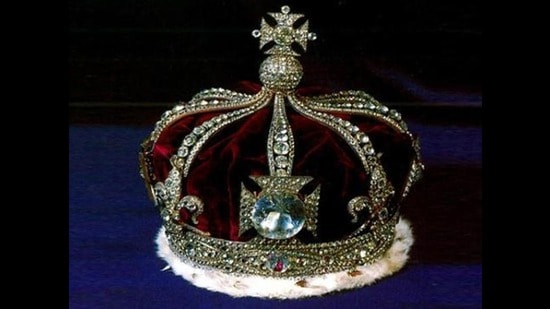
“Repatriating items is a small but important issue for museums today,” says Vinod Daniel, a museologist and member of the Board of the International Council of Museums. “Today, if a museum knows that an object’s provenance is dubious, they won’t acquire it. Due diligence of religious items is especially high. But when an object is more than 100 years old, and has changed hands over many generations, where do you draw the line?”
The art of the steal
For some, that line is clear. “Any and every heritage item taken from India without consent is illegal and should be returned to us,” says Anuraag Saxena, co-founder of the non-profit India Pride Project, which has helped the government identify artefacts that rightfully belong in India. “It’s abhorrent that some nations have normalised institutionalised kleptomania,” Saxena adds.
That moral argument has global backing. More than 100 countries ratified a 1970 UN convention banning the trafficking of culturally significant items, and endorsing the return of objects that were found or even suspected to have been stolen. India was among those countries.
There’s global support for the idea that artefacts are best experiences in their intended locations and contexts – Buddha idols in their stupas, ceremonial swords in palace galleries, and so on. They can potentially boost tourism and offer tangible reminders of local history and culture.
Restitution might even save lives. A 1998 study by Michael Chandler and Christopher Lalonde at the University of British Columbia suggests that one factor contributing to the high rate of suicide (sometimes 800 times higher than the average) among Canada’s indigenous First Nations people is cultural discontinuity. The absence of cultural continuity puts both individuals and communities at risk, states their report, published in the journal Transcultural Psychiatry.
“As a nation we are dealing with post-traumatic stress disorder. Centuries of barbaric attacks, colonisation, mass-murder and loot can shatter the self-confidence of a community. It can really dilute your sense of self-worth,” says Saxena, making the same case for India.
Holding on
And yet, while collectors and museums show enthusiasm about re-assessing their hoards, actual returns are sporadic, delayed and keenly contested. Many offer the patronising argument that Western museums are better custodians than the home countries. That the items get more viewers and allow for a multicultural museum experience.
With objects from former colonies, museums and governments often demand proof that the object was illegally taken, shifting the burden of proof from the coloniser to the colonised.
When records are presented — as they were in the case of the Koh-i-noor, which the 10-year-old Duleep Singh was forced to give up to the British East India Company after losing the Second Anglo-Sikh War in 1849 — countries shrug them away saying the objects were acquired under laws deemed appropriate by them at the time.
Of course, not every India artefact now abroad was looted. Many were given away, legitimately sold or gifted, as with the sword of the Maratha warrior-king Shivaji, which Shivaji IV of Kolhapur presented to the Prince of Wales in 1875.
So how do we make claims for the return of items we believe are rightfully ours? Increasingly, in cases involving former colonial powers, when it’s one country’s word against another’s, the growing consensus is that the object ought to simply be returned. It’s one kind of restitution, in a world where so much more is due.
Meanwhile, India must consider its own role in hoarding objects too. Many artefacts from the Indus Valley Civilisation, which were unearthed before Partition in regions that are now in Pakistan, remain in India, amid calls for them to be sent across the border. Could we part with the Dancing Girl, excavated from Mohenjo-daro in the 1920s?
Lines suddenly start to blur. Even Saxena isn’t sure. “Most public objects were made for communities,” he says. “If those communities still exist in Pakistan or Bangladesh, and if they were to make a legitimate claim, then of course India should consider it.”
That response is leagues better than the one issued by the British Museum, when Egypt officially asked for the Rosetta stone to be returned in 2003. The museum argued that the object, which Napoleon’s soldiers stumbled upon in 1799, was then merely a stone with an inscription in three languages. It was the British who seized it in 1801 and ended up deciphering the hieroglyphics, unlocking the ancient language of the pharaohs. Of course, as the joke goes, if the British Museum returned everything it had taken without permission, all it might be left with are some ancient dentures and a wooden toothbrush.
.
TREASURE TRAIL
Some of India’s most breathtaking antiquities reside in collections abroad, acquired through sales, donors, cultural and diplomatic exchanges and, occasionally, relic hunters. Here’s what to check out on your travels.
The Nawanagar ruby necklace
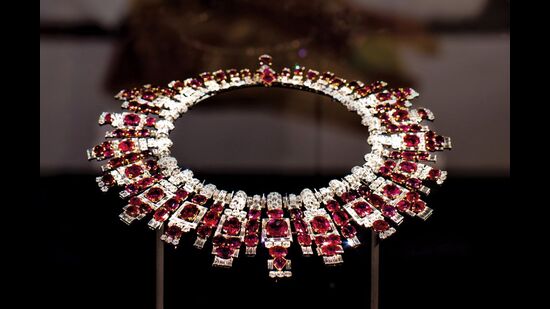
The French jewellery house Cartier designed this platinum, ruby and diamond necklace for Maharaja Digvijaysinh of Nawanagar (present-day Jamnagar in Gujarat) in 1937. The oval and cushion-cut Burmese rubies were collected by the king’s predecessor, Maharaja Ranjitsinh. The necklace was sold to Cartier after Independence, when erstwhile royals were allowed to retain their personal possessions but had to turn over most of their immovable assets to the Indian government. The design has since been altered to suit a woman’s frame.
On view as part of the Al Thani collection at the Hôtel de la Marine in Paris. Built up by Sheikh Hamad bin Abdullah Al-Thani, a Qatari prince, over the last 15 years, the collection spans 6,000 items. The jewellery section is considered the world’s greatest assemblage of private jewellery.
.
Emperor Jehangir’s wine cup
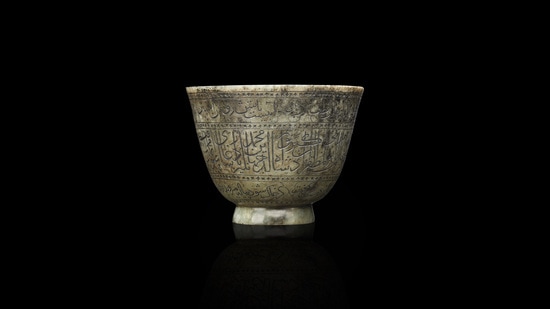
Three bands of calligraphy adorn this jade cup belonging to the 17th-century Mughal emperor. Forming the central band, carved in sols script, is a royal dedication announcing that the cup was made for Jehangir. At the top, in nasta’liq script, the text states that it was made in the second year of his reign (between 1607 and 1608). Also engraved are lines from Persian poetry of the time. The emperor was fond of wine even though Islam forbade the drinking of alcohol.
On view at the Hôtel de la Marine, as part of the Al Thani collection alongside objects from ancient Egypt and Rome, medieval Europe, imperial China and Mughal India.
.
Shah Jahan’s archery ring
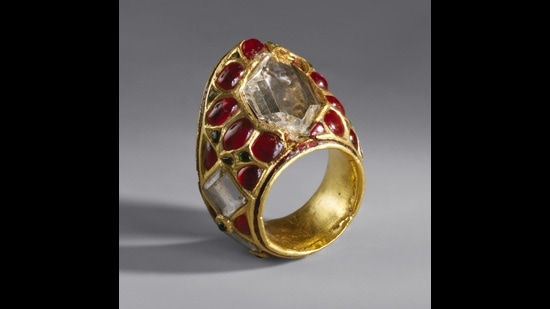
Shah Jahan (1628 -1658) wore this ring, made with gold, diamonds, 21 rubies and 14 emeralds, on his right thumb, to protect it when pulling a bowstring. The diamond at the centre is six carats. The ring was among the treasures looted by the army of Nadir Shah of Iran (1736-47), when they attacked the Mughal empire in 1739. Some of the items, including this ring, were presented, in a diplomatic gesture, to the Tsarina Elizabeth Petrovna of Russia in 1741.
On view at the State Hermitage Museum in St Petersburg, Russia.
.
The Infant Christ as the Good Shepherd
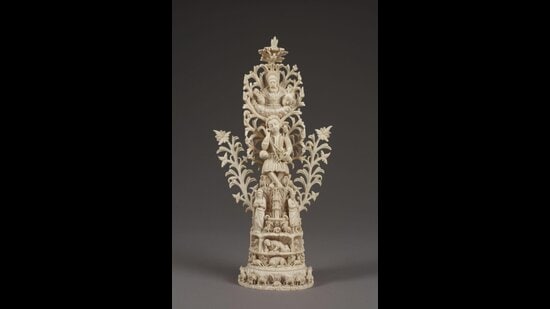
Christ, depicted as a young shepherd, sleeps under the watchful gaze of God and the Holy Spirit. A step beneath are Joseph and Mary; Mary Magdalene reclines at the base, reading. The style is unique to 17th-century Goan ivory work, which the Portuguese commissioned as diplomatic gifts. It’s a good example of how local craftsmen fused indigenous iconography (note the local foliage) into Christian themes despite Church control.
On view at the Victoria and Albert Museum, London, which has a vast collection of objects from the subcontinent, collected largely during colonial rule. This item was acquired from an American collector in 1949.
.
Sultanganj Buddha
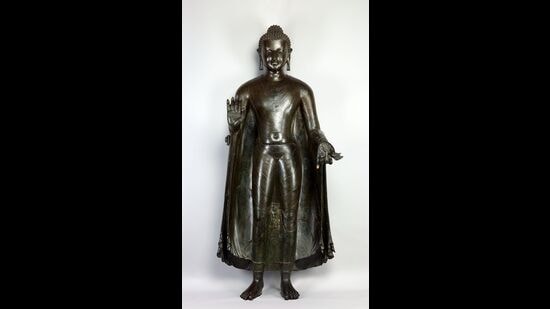
This artefact was unearthed in Sultanganj, Bihar, in 1861, during the construction of the East Indian Railway. The 2.3-metre Gupta-Pala period copper sculpture of the Buddha was shipped to Birmingham in 1864 to inspire metalworkers there.
On view at the Birmingham Museum and Art Gallery, where it is the star attraction. Until 2015, the museum would host an annual Buddha Day, when local Buddhist groups would pray at the statue.
.
The charter of King Rājendra I

It weighs 30 kg, dates to the 11th century and its 21 copper plates are held together by a massive bronze ring bearing the seal of Chola king Rājendra I (1012-1042). Inscribed on the plates, in Sanskrit and Tamil, is the Chola dynasty “lineage”, all the way back to the Hindu god Vishnu, and achievements of Rājendra I’s father, Rājarāja I (r. 985-1012).
On view at the Leiden University Library in the Netherlands. It’s commonly referred to as the Leiden Plates. The artefact was brought to Europe by a religious minister in 1703-12 and donated to the museum by the estate of a professor in 1862. It is not clear how the minister acquired them in India.
.
Golden throne of Maharaja Ranjit Singh
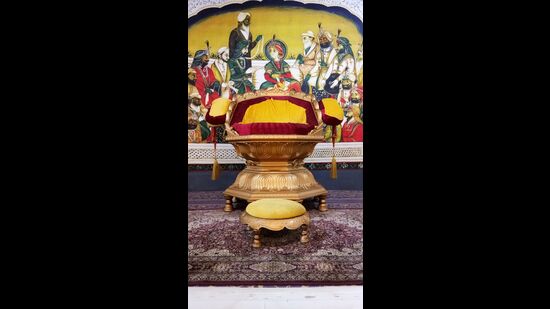
Ranjit Singh (1780-1839), founder of the Sikh empire, preferred to sit on a carpet on the floor. He used this golden throne for state occasions. Commissioned in 1820 and crafted in wood and gold, it is shaped like a lotus. When the British East India Company annexed Punjab in the Second Anglo-Sikh War in 1849, soldiers took the throne to England as state property.
On view at the Victoria and Albert Museum, London. Sikh groups have campaigned for its return to India, but the museum has rejected all claims.
.
Tipu Sultan’s mechanical tiger
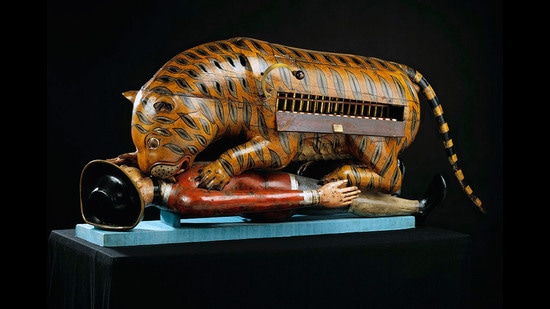
Known simply as Tipu’s Tiger, it’s a mechanical device made in 1795 for the king of Mysore. The sultan saw himself as a tiger — the animal appeared in his emblem, signature and palace motifs. The artefact depicts a tiger attacking a European soldier, with sound effects of grunts, wails, flailing hands and all. It was part of the treasures taken to England when the British East India Company stormed Tipu’s palace in 1799.
On view at the Victoria and Albert Museum, London.
.
The Witsen album
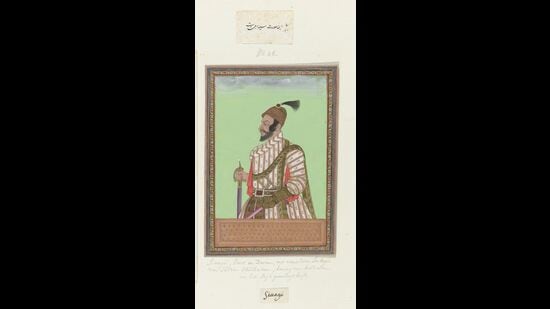
A collection of 49 miniature works, made in 17th-century Golconda (present-day Hyderabad), to help European textile traders familiarise themselves with India. The collection features portraits of rulers including Maratha warrior-king Shivaji (above), Mughal emperor Akbar and Kachwaha Rajput ruler Man Singh. They were brought to the Netherlands in 1686.
On view at the Rijksmuseum, Amsterdam. The collection is named for the Dutch colonial administrator Nicolaas Witsen.
.
Amaravati marbles
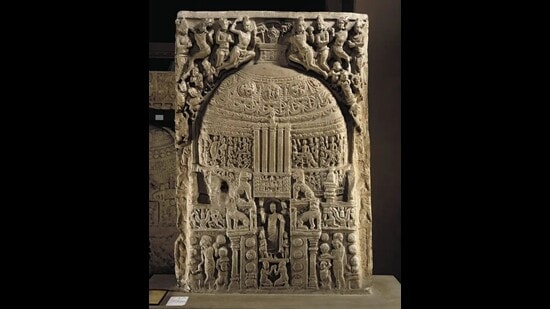
Amaravati in present-day Andhra Pradesh was the site of a key Buddhist shrine in 200 BCE. The grand stupa featured 120 marble sculptures, inscribed railings, entryways and carved relief panels illustrating some of the Jataka tales. Excavated in 1845, the stupa was dismantled, and the majority of the pieces shipped to London, just as the East India Company was being dissolved.
On view at the British Museum, which has a dedicated Amaravati Marbles gallery. Some excavated objects from Amaravati are at the Government Museum in Chennai and at a small museum in Guntur.
Enjoy unlimited digital access with HT Premium
Subscribe Now to continue reading

Stay connected with us on social media platform for instant update click here to join our Twitter, & Facebook
We are now on Telegram. Click here to join our channel (@TechiUpdate) and stay updated with the latest Technology headlines.
For all the latest Art-Culture News Click Here

